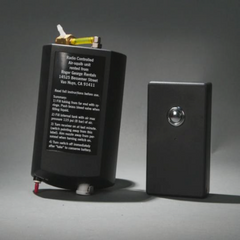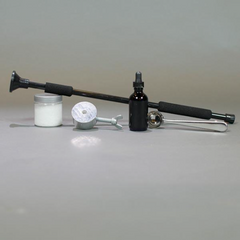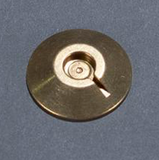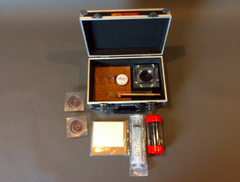Top 5 Ways To Create Bullet Hit Effects
On the vast majority of productions, professional effects operators in Hollywood typically use these five approaches to create bullet hit effects.
1. DUST HITS AND ZIRC HITS

WARNING: DO NOT EVER FIRE DUST HITS, ZIRC HITS, OR TECHNO DUST BALLS AT PEOPLE OR ANIMALS.
Probably the most common way of creating a bullet hit effect is with Dust Hits and Zirc Hits fired from a paintball gun. (Zirc hits can be purchased by phone or in-store ONLY with appropriate licensing.)
Dust hits are great for creating the appearance of bullets hitting dirt, sheetrock, brick walls, and concrete. For recreating a bullet hit on metal, rock, and concrete the pros use zirconium hits.
Dust Hits and Zirc Hits are .68 caliber plastic balls filled with colored dust or a special formulation that contains zirconium. These hits can be fired out of a standard .68 caliber paintball gun or a Sweeney Gun. On impact, Dust Hits throw a cloud of colored dust giving the impression of an impact. If you’re recreating a bullet hit on metal use Zirc Hits. On impact, the zirconium creates a flash of sparks resembling the impact of an actual bullet hitting a hard surface.
You may want to consider using Techno Dust Balls.

Techno Balls are paintball sized dust hits with dimpled covers. The dimpling makes the balls fly straighter and farther. The shell is also made of a material that will crumble without forming sharp edges.
2. COMPRESSED AIR BULLET HIT EFFECT (AIR SQUIB)
The least complicated way to create bullet hit effects on a person uses compressed air to force a jet of gooey blood through the costume. The compressed air approach is non-pyrotechnic so you don’t need state or federal licensing to create them. Compressed air bullet hit effects are also far easier to rig because you do not have to build blood bags, wire pyro charges, and program a firing system.If you would like to see how to rig a Compressed Air Bullet Hit Effect, check out the video Air Squib Bullet Hit at the bottom of the Air Squib Kit product page.
The basics are:
-
Fill a length of surgical tube with Air Squib Blood (much thinner than stage blood)

-
Attach tube to Air Squib Nozzle and attach nozzle to costuming

- Blow compressed air through tube to force out the blood
Using the setup described above, we’ve been able to generate enough force to push blood through T-shirt material using a Transfer Syringe instead of the Air Squib Unit. The downside of using a syringe to generate pressure is that in order to trigger it, the operator needs to be close to the talent while the camera is rolling.
If you use a syringe to generate compressed air, figuring out how to position the operator so they’re not in the shot may take a bit of planning.
There's also The Air Squib Kit which features an easy to conceal device to deliver the compressed air and a wireless controller.

The wireless remote allows the operator to stand well off camera—which makes planning a whole lot easier.
The Air Squib Nozzle, Air Squib Tape, Tubing, Air Squib Blood, and Syringe are available separate from the Air Squib Kit.
3. STEARIC ACID (BRITTLE WAX) GUN

A frequently used approach to recreate bullet hit effects on skin is with stearic acid (brittle wax) capsules filled with stage blood. Effects operators make their own brittle wax capsules then propel them at LOW VELOCITY at the talent. On impact the capsule bursts leaving a glob of stage blood.If you would like to see a demonstration of how to build brittle wax blood capsules, check out the video Stearic Acid Gun on The Stearic Acid Gun Kit product page. The video shows how to build your own blood capsules AND demonstrates what they look like on camera!
4. STANDARD BULLET HIT/BLOOD BAG
On movies and TV shows with big production budgets, professional operators use small pyrotechnic charges to recreate the effect of a bullet hit.-
On Sheetrock
The pros drill holes on the back of the sheetrock that go almost all the way through. Then the stick a small pyrotechnic charge in the hole. On detonation, the pyrotechnic charge blows a hole that looks real.
-
On Cinderblock
When creating bullet hit effects on cinder blocks, operators often mold fake blocks out of Gypsnow. (Gypsnow is a very light and very fragile material that looks like concrete.) Then the effects guy puts pyrotechnic charges inside the blocks. When the charge goes off, it creates a hole and terrific looking debris.
Effects operators will also drill small holes in the fake cinder blocks, insert a small pyrotechnic charge, and cover the hole with ultralight spackle (ultralight dries in minutes). This approach produces round holes that, depending on the size of the pyrotechnic charge, can vary in size from the diameter of a finger to the diameter of a baseball.
-
On People
Bullet hit effects on people are sometimes called blood hits or squibs. You typically only see them on productions with sizeable effects budgets.
The reason for all the licensing and practical experience is that rigging a blood hit on a person is a complex process. That process needs to be done very carefully to ensure the safety of the talent and to get the device to fire when the cameras are rolling.
In the simplest form, a pyrotechnic blood hit involves:
- Filling a bag with blood.
-
Attaching a pyrotechnic charge that is secured to a brass shield to the blood bag.

-
Attaching a large square of sorbothane behind the shield.

- Distressing the wardrobe at the spot of the bullet hit.
- Securing that pack to the interior of costuming so it is in line with the distressing.
- Firing the charge on cue.
The wardrobe needs to be distressed to ensure that the charge will create a hole in the costuming. That there is a softened exit point for the force of the charge means that there is far less energy shot back at the talent.
As mentioned before there’s a balance to be struck when distressing fabric. The operator weakens the material enough so the charge will pop through, but not so much that the fabric will fall apart or the distressing will be visible on camera.
5. THE HIT KIT

A new approach to creating blood hits on people is with The Hit Kit.
The Hit Kit was developed in order to use lead-free pyrotechnic (T12 Series) charges for blood hits on people. It features a reusable high-impact plastic shield specifically engineered to seat a T12 Series charge. The shield also holds ¾ ounce of stage blood.
The Hit Kit streamlines the process of building blood hit packs, dramatically reducing production time. For a demonstration on how to assemble blood hit squibs, take a look at the video Hit Kit Squib Bullet Hit at the bottom of The Hit Kit product page. The video also features several great demonstrations of Hit Kit style squibs in action, so you can see what they look like on camera.
If you have any questions or want to share your tips for creating practical bullet hits, please leave a comment below.







Leave a comment